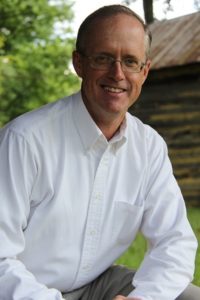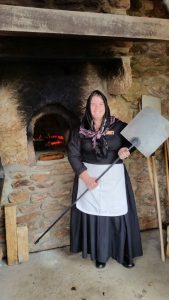An Ancient Oven and the Body of Christ
By Tim Tron
Burke County
“And Jesus said unto them, I am the bread of life: he that cometh to me shall never hunger; and he that believeth on me shall never thirst.” – John 6:35
It was a rainy, overcast Saturday when in the moment of time, I found myself leading a tour at the Trail of Faith in Valdese, NC. As my group stood with me in front of the replica of a Waldensian Community Oven, huddled in close, trying to stay dry, I began trying to convey how important bread was to those ancient people’s diet.
A community oven could be found in every village of those Alpine valleys. As my words drifted along like the water dripping from the eaves of the structure underneath we stood, I realized how much this group of young people were more like those ancient peoples than their local Waldensian descendants. The entire struggle of making bread in such an antiquated stove very much paralleled the lives of these visiting youth.
Coming from the Caribbean Islands and South America, they were part of an evangelism outreach program called “The Megabook Group.” Their approach to evangelism was one of unbridled, unrestrained passion. The group’s American leader espoused their unequivocal ability to reach people that others of our colloquial resources were unable to match. But this fruit of the spirit which they portrayed began long before arriving on our continent. Theirs began in those humble homes, shelters that were often a mere shadow of our American middle-class dwellings. Their parents had raised them in Biblical perspectives that were Christ-centered, free from Western cultural influences. These young people’s journey began long before they boarded the airplane to arrive at our Western secular shores. Their story very much paralleled the story of the bread that this ancient oven would eventually produce.
As I shared how the bread was made, describing the oven’s use in that process and attempting to convey what it was to taste that freshly baked loaf of succulence after it was just pulled from the hot coals seemed wholly insufficient. There was just so much behind the story that one couldn’t know until it was experienced. In many ways, it has a very close correlation to how we come to know the Gospel of Christ – what seems delectable becomes ever more so when one understands the effort and struggle that went into bringing that morsel into being.
Many have died to preserve the Word of God. That representation of God in the flesh was as to us as manna from Heaven. Jesus said, “I am the bread of life: he that cometh to me shall never hunger; and he that believeth on me shall never thirst.”
Once upon a time, when I was the Director at the Trail, it occurred to me that the experience, the idea of bringing the Waldensian story to life, would be made even more realistic if we actually baked bread in the outdoor oven. After all, the replica was designed distinctly after one that existed in the Waldensian Valleys. Now, one of the most challenging parts of this endeavor had already been accomplished. The oven at the Trail was beautifully crafted. The stone masons had created a work of art using the field stones from the Burke County area. The replica was a fitting tribute to its predecessor. Now all that was left to do was to figure out how to bake bread in it. But there was one small catch – there were no directions.
As in our search for Jesus, trying to go it alone can often be difficult, if not impossible. We need a guide. Jesus told his disciples that he would send a Comforter to guide them. And it is through the Holy Spirit and the Word that we are led. Yet, many still fail to follow the guide even reading God’s word. Many attend church expecting the preacher to spoon-feed them every word instead of seeking it themselves. When you genuinely want to know something, you must seek it. As Jesus told the woman at the well, “But the hour cometh, and now is, when the true worshippers shall worship the Father in spirit and in truth: for the Father seeketh such to worship him.”
As in the case of our oven and how we were to use it – something that had been passed down from generation to generation had all but been lost. Then there were the physical challenges; our replica also had no door for the opening, and there were no temperature gauges or controls. There was much to learn before that first loaf was ever made. My search for understanding led me to several dead-ends, most of which were the locals in Valdese that hadn’t ever actually used a working oven like ours – the ancient style. Again, another parallel.
Unlike those ancient Waldensians, many, but not all, of their descendants cannot even begin to compare their commitment to faith as were their ancestors. Their faith had not been passed down from one generation to the next as in the days of old. Yes, it’s easy to say you would die for your belief in God, but to find yourself burning at the stake, quoting scriptures from the heart as the flames tore into your very being, melting the flesh from your bones, is a different story. There is seldom any comparison between most modern believers to those of ancient times.
To know one’s destination, one has to find it. Seeking something you want to reach without a map can be troubling, if not irritatingly frustrating. When we have nothing to read or study, we have to search for clues, for aspects of that goal which we want to achieve possibly left behind by our predecessors, or someone that successfully reached that special place, leaving hidden gems of knowledge for us to use. Imagine trying to find God without the Bible or anyone that knew anything about Jesus. You can honestly say it would be very difficult, if not impossible.
The oven itself was a semi-circular-shaped dome with a flue just outside the door. Years before I arrived, it had been used during an event with the help of an elderly couple that had used one like it back in the original valleys. Sadly, they had passed. All that was left were the traces of smoke residue and the tools they had used to control the fire and remove the ashes. But from what I could discover through the inspection and understanding of what little was available on the internet, it was a matter of placement of fire and control of the temperature. The idea was that the fire would be built on the oven’s floor, then after the chamber reached the right temperature, the fire would be removed, the floor mopped clean, and then the door closed, maintaining the heat for several hours. This allowed the whole village to bake their bread in one day, enough to last a week or more. To come together as a community, as Paul described in Acts 2:42, “And they devoted themselves to the apostles’ teaching and the fellowship, to the breaking of bread and the prayers.”
Again, the search for instruction on how to make the old hearth work is much like the unbeliever’s search in today’s world, looking for answers about God. There are places on the internet, others who can be sought out for understanding, and there can be traces as the smoke on the flue, watching the actions of other Christians. The latter is probably the most significant sign of all.
It took several hours of trial and error before we eventually found the proper process to produce that first golden loaf. But that was not even the start of our challenges. Before we could begin the first fire, we had to find firewood. So, gathering as much help as possible, we were provided the forest to find the trees, but we had to go and do it physically. This meant cutting the trees, hauling the wood, then stacking it near the oven. There, by the oven, we began splitting the wood by hand. In all, even though we hadn’t built the oven ourselves, we soon learned that to bring a single loaf to life, there would be a lot of work behind the scenes, much like ministry.
Although someone might find their way to Christ alone, usually, there is a concerted effort made by a group or outreach organization to make it happen. There may be years of study, worship, and devotion behind those souls who go out and share the Good News of the Gospel of Jesus Christ. It is most assuredly never the “add water” version of evangelism. Even in Christ’s time, many misunderstood his mission. As Jesus quickly found, after the feeding of the five thousand, they came looking the next day for more food. He marveled that they saw the miracles, but their spirits were not filled, only their bellies. He told them, “Truly, truly, I say to you, you are seeking me, not because you saw signs, but because you ate your fill of the loaves. Do not work for the food that perishes, but for the food that endures to eternal life, which the Son of Man will give to you. For on him God the Father has set his seal…” In other words, just eating the right food isn’t going to save you. Living right isn’t going to send you to heaven. There is an effort that must be made to find Him and to receive Him into your heart. We are saved by Grace and not by works alone.
Now, through all of this, the gathering, cutting, and splitting of the firewood, there was a component of the struggle that uniquely, unexpectedly incorporated the help of several people, all of whom were attracted to the idea of making bread in an ancient outdoor oven. As time would tell, that camaraderie of effort soon turned into a fellowship of sharing the Gospel. You see, even though we had a destination in mind, there were hungry souls to be fed along the way. As we worked, we talked about the implications of sharing the bread on the Trail and how it might be perceived. We talked about how Jesus was the bread of life and how folks would receive this as part of their tour experience. This drew many discussions, which increased the awareness, and the reality of scriptures, bringing them to life before we even baked the first loaf.
While that group of young people listened to me describe how we made the fire in that ancient chamber of stone, they had no idea of the extent of time that would go into that moment. When we would pull out a golden brown, delectable-smelling loaf of bread from that oven, there would be countless hours of work, but even more rewarding, of fellowshipping with all who made that moment possible. It is no wonder that even the group that day had no idea of the beauty, the smell, or the inexplicably gratifying image of seeing the representation of the body of Christ being pulled from the hearth on a spatula fitting for an ancient oven to behold the Glory before you.
There are almost no words with which can adequately form the impression that we found the day that the first loaf was placed before the unsuspecting tour group. As we fed them the hot, fresh bread and said, “This is the body of Christ broken for you,” there was no wonder, and without expectation, as tears began to flow from the guests and, soon, those servers as well. We never realized the impact that all that had been done would lead to that moment when the Holy Spirit would come down and join us. This scene would repeat itself again and again, as we found that there was something beyond exceptional at the ancient outdoor oven.
When the Gospel is given genuinely, without pomp or circumstance, in the original form for what it is, as Christ died for our sins, and that we can remember him each time we break bread in fellowship with one another, it is no wonder that when we do as He taught, we cannot help but be amazed at what the Holy Spirit can do through us. Alone, we are nothing. But when we receive the power from on High, we become more than we can be alone.
Christ told his disciples before the ascension, “And, behold, I send the promise of my Father upon you: but tarry ye in the city of Jerusalem, until ye be endued with power from on high.” And after which, he instructed them, “Go ye therefore, and teach all nations, baptizing them in the name of the Father, and of the Son, and of the Holy Ghost: Teaching them to observe all things whatsoever I have commanded you: and, lo, I am with you always, even unto the end of the world. Amen.”
Yes, go forth like those amazing young people from the Megabook Group, unashamed, unafraid, evangelizing in the name of the Father, Son, and the Holy Ghost unto the ends of the earth. Time is short. Eternity awaits. And lastly, remember, He will be with us to the end.
Thanks be to God.
_____________________________________
Timothy W. Tron lives in Collettsville, NC. with his family. He is currently the Systems Administrator for the Computer Science Department at App. State. Timothy is the former Director of the Trail of Faith in Valdese, where he still volunteers and helps with tours. He is the author of a new Christian series, “Children of the Light”, with the first book being, “Bruecke to Heaven”, revised as “Bridge to Heaven”, and his recent book, being the second, “The Light in the Darkness”. He is an active blogger, artist, and musician. Timothy also has a BSEE from UF, and is a Lay Speaker. He is currently acting as the Faculty/Staff Liaison for the Ratio Christi campus ministry at App. State. He can be reached at trontw@appstate.edu You can visit his website at //www.timothywtron.com/ or see more of his writings HERE
_____________________________________






